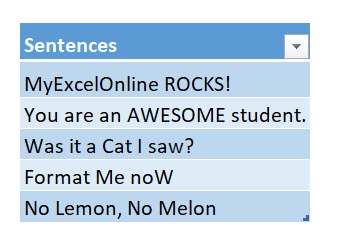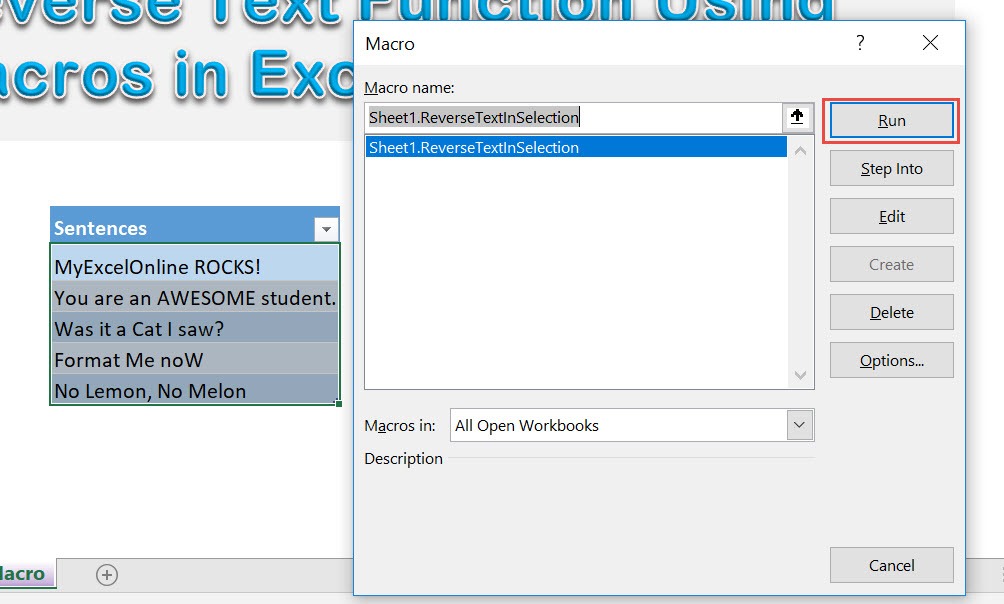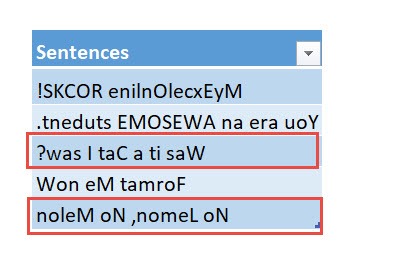Want to have fun with your text and see it displayed backwards? Whether it’s for a playful project, a coding exercise, or just to impress your friends, Excel can do this for you in a single click using Macros. With a few simple steps, you can convert any text in your worksheet into its reverse—letter by letter, word by word, or even entire sentences.
In this guide, we’ll explain exactly how to reverse text in Excel using Macros, provide ready-to-use code, and walk you through testing it with your own data. By the end of this tutorial, you’ll have a fully functioning Reverse Text Macro that’s fun and practical.
Key Takeaways:
- Excel Macros can reverse text in a single click, making it fun and interactive.
- The ReverseText function reverses text letter by letter in any selected cell.
- Palindromes remain unchanged when reversed, providing a playful twist.
- The macro works on multiple cells simultaneously, saving time on large datasets.
- Learning to use macros for text manipulation opens doors to more advanced Excel automation.
Exercise Workbook:
Table of Contents
What Does the Reverse Text Macro Do?
Before we dive into the steps, let’s understand what this macro actually does.
- The macro takes your selected cells containing text.
- It converts each string into its reverse form, letter by letter.
- The original cell content is replaced with the reversed text.
For example:
- Excel Macros – sorcaM lecxE
- Hello World – dlroW olleH
- Was it a Cat I saw? – ?was I taC a ti saW
How to Implement and Test the Reverse Text Macro
Enable Developer Tab
STEP 1: Go to File > Options > Customize Ribbon.
STEP 2: Check Developer in the right panel and click OK.
The Developer Tab gives you access to the VBA Editor and macros.
Write VBA Code
This is our list of text. We’ve added a couple of palindromes in here for good measure! A palindrome is when you reverse the text it reads completely the same!
STEP 1: Go to Developer > Code > Visual Basic
STEP 2: Paste in your code and Select Save. Close the window afterwards.
Public Function ReverseText(ByVal cell As Range) As String 'Reverse text using this function ReverseText = VBA.strReverse(cell.Value) End Function 'Make sure you have a selection ready Sub ReverseTextInSelection() Dim range As Range Selection.Value= Selection.Value 'Loop through all the cells For Each range In Selection 'Call your function range= ReverseText(range) Next range End Sub
We have also added a function in #1 to show you on how we define custom functionality. Then in #2 we refer to this function and use this functionality that we have created.
STEP 3: Let us test it out!
Open the sheet containing the data. Go to Developer > Code > Macros
Make sure your text and macro are selected. Click Run.
With just one click, all of your text are now reversed! Notice the ones in red read exactly the same:
- Was it a Cat I saw?
- No Lemon, No Melon
Tips for Using Reverse Text Macros
- Always save a backup: Macros change your cell content permanently, so it’s best to keep a backup.
- Enable macros: Excel disables macros by default for security reasons. Make sure they’re enabled.
- Use with multiple cells: You can select multiple rows or columns—our macro handles them all.
- Custom functions: The ReverseText function can be reused in other macros or even in formulas.
- Have fun: Try it with long sentences, special characters, or even numbers to see the effect.
FAQs
Q1: What does the Reverse Text Macro do?
The Reverse Text Macro takes your selected cells and reverses the text in each cell. It works letter by letter, replacing the original content with its reversed form. You can use it on single cells, rows, columns, or entire selections. Palindromes remain unchanged when reversed. This makes it both a fun tool and a practical example of Excel automation.
Q2: Do I need programming knowledge to use this macro?
No advanced programming knowledge is required. You only need to copy the provided VBA code into a new module in the VBA Editor. Basic familiarity with Excel, like enabling the Developer Tab and running macros, is sufficient. The macro handles all the reversing automatically. It’s designed to be beginner-friendly and easy to implement.
Q3: Can I reverse text in multiple cells at once?
Yes, the macro is built to handle multiple selected cells simultaneously. It loops through each cell in your selection and applies the reversal function. This makes it efficient for large datasets or long columns of text. You don’t need to run the macro repeatedly for each cell. Just select the range and run the macro once.
Q4: Are there any precautions I should take before using the macro?
Yes, always save a backup of your workbook first because macros overwrite the original cell content. Make sure macros are enabled in Excel, as they are disabled by default for security reasons. Test the macro on a small range first to ensure it behaves as expected. Palindromes and special characters are handled correctly, but it’s good to double-check. Following these steps avoids accidental data loss.
Q5: Can I customize the macro for other text manipulations?
Absolutely! The ReverseText function can be reused in other macros or formulas. You can modify it to reverse words instead of letters, handle substrings, or apply formatting changes. You can even assign a keyboard shortcut for quick access. With a bit of experimentation, this macro becomes a starting point for more advanced Excel automation projects.

Bryan
Bryan Hong is an IT Software Developer for more than 10 years and has the following certifications: Microsoft Certified Professional Developer (MCPD): Web Developer, Microsoft Certified Technology Specialist (MCTS): Windows Applications, Microsoft Certified Systems Engineer (MCSE) and Microsoft Certified Systems Administrator (MCSA).
He is also an Amazon #1 bestselling author of 4 Microsoft Excel books and a teacher of Microsoft Excel & Office at the MyExecelOnline Academy Online Course.
















